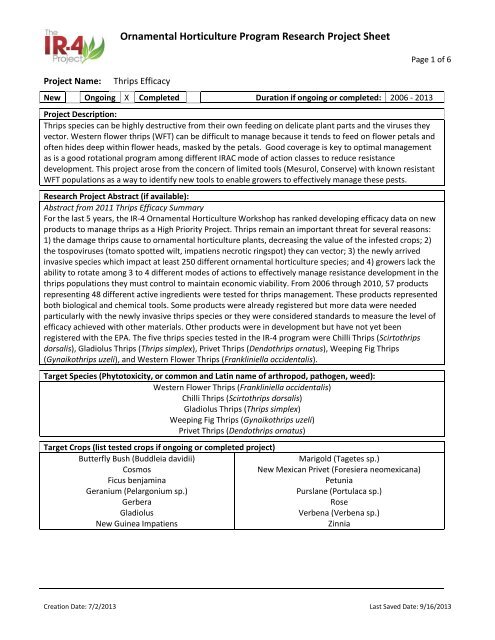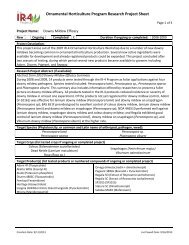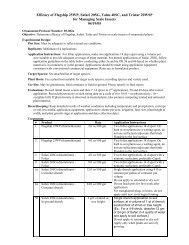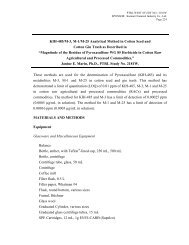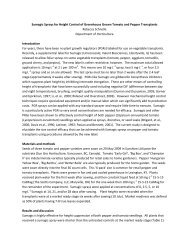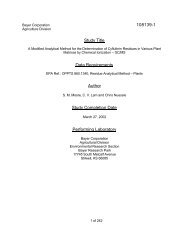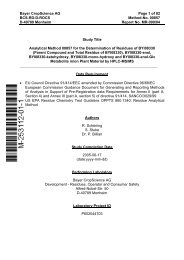Thrips - IR-4 Project
Thrips - IR-4 Project
Thrips - IR-4 Project
You also want an ePaper? Increase the reach of your titles
YUMPU automatically turns print PDFs into web optimized ePapers that Google loves.
Ornamental Horticulture Program Research <strong>Project</strong> Sheet<br />
<strong>Project</strong> Name:<br />
<strong>Thrips</strong> Efficacy<br />
Page 1 of 6<br />
New Ongoing X Completed Duration if ongoing or completed: 2006 - 2013<br />
<strong>Project</strong> Description:<br />
<strong>Thrips</strong> species can be highly destructive from their own feeding on delicate plant parts and the viruses they<br />
vector. Western flower thrips (WFT) can be difficult to manage because it tends to feed on flower petals and<br />
often hides deep within flower heads, masked by the petals. Good coverage is key to optimal management<br />
as is a good rotational program among different <strong>IR</strong>AC mode of action classes to reduce resistance<br />
development. This project arose from the concern of limited tools (Mesurol, Conserve) with known resistant<br />
WFT populations as a way to identify new tools to enable growers to effectively manage these pests.<br />
Research <strong>Project</strong> Abstract (if available):<br />
Abstract from 2011 <strong>Thrips</strong> Efficacy Summary<br />
For the last 5 years, the <strong>IR</strong>-4 Ornamental Horticulture Workshop has ranked developing efficacy data on new<br />
products to manage thrips as a High Priority <strong>Project</strong>. <strong>Thrips</strong> remain an important threat for several reasons:<br />
1) the damage thrips cause to ornamental horticulture plants, decreasing the value of the infested crops; 2)<br />
the tospoviruses (tomato spotted wilt, impatiens necrotic ringspot) they can vector; 3) the newly arrived<br />
invasive species which impact at least 250 different ornamental horticulture species; and 4) growers lack the<br />
ability to rotate among 3 to 4 different modes of actions to effectively manage resistance development in the<br />
thrips populations they must control to maintain economic viability. From 2006 through 2010, 57 products<br />
representing 48 different active ingredients were tested for thrips management. These products represented<br />
both biological and chemical tools. Some products were already registered but more data were needed<br />
particularly with the newly invasive thrips species or they were considered standards to measure the level of<br />
efficacy achieved with other materials. Other products were in development but have not yet been<br />
registered with the EPA. The five thrips species tested in the <strong>IR</strong>-4 program were Chilli <strong>Thrips</strong> (Scirtothrips<br />
dorsalis), Gladiolus <strong>Thrips</strong> (<strong>Thrips</strong> simplex), Privet <strong>Thrips</strong> (Dendothrips ornatus), Weeping Fig <strong>Thrips</strong><br />
(Gynaikothrips uzeli), and Western Flower <strong>Thrips</strong> (Frankliniella occidentalis).<br />
Target Species (Phytotoxicity, or common and Latin name of arthropod, pathogen, weed):<br />
Western Flower <strong>Thrips</strong> (Frankliniella occidentalis)<br />
Chilli <strong>Thrips</strong> (Scirtothrips dorsalis)<br />
Gladiolus <strong>Thrips</strong> (<strong>Thrips</strong> simplex)<br />
Weeping Fig <strong>Thrips</strong> (Gynaikothrips uzeli)<br />
Privet <strong>Thrips</strong> (Dendothrips ornatus)<br />
Target Crops (list tested crops if ongoing or completed project)<br />
Butterfly Bush (Buddleia davidii)<br />
Marigold (Tagetes sp.)<br />
Cosmos<br />
New Mexican Privet (Foresiera neomexicana)<br />
Ficus benjamina<br />
Petunia<br />
Geranium (Pelargonium sp.)<br />
Purslane (Portulaca sp.)<br />
Gerbera<br />
Rose<br />
Gladiolus<br />
Verbena (Verbena sp.)<br />
New Guinea Impatiens<br />
Zinnia<br />
Creation Date: 7/2/2013 Last Saved Date: 9/16/2013
Ornamental Horticulture Program Research <strong>Project</strong> Sheet<br />
Target Product(s) (list tested products or numbered compounds if ongoing or completed project)<br />
Page 2 of 6<br />
A16901B<br />
Acelepryn<br />
Allectus SC<br />
Aloft SC<br />
Aria 50SG<br />
Avid 0.15EC<br />
AzaGuard<br />
BAS 320i<br />
BotaniGard 22WP<br />
BotaniGard ES<br />
Capsil<br />
Carzol<br />
Celero 16WSG<br />
Conserve SC<br />
Diazinon 50W<br />
Dimethoate 4EC<br />
Discus<br />
DPX-HGW86<br />
Dursban 50W<br />
EcoTrol<br />
Flagship 25WG<br />
Hachi-Hachi<br />
Kontos<br />
Marathon 1G<br />
Marathon II<br />
Marathon Ultra<br />
MBI 203 DF<br />
MBI 206 F<br />
Mesurol 75W<br />
Met52<br />
MilStop<br />
MOI201<br />
NNI-0101<br />
OHP 929-2<br />
Orthene TTO<br />
Overture 35WP<br />
Pedestal<br />
Proud 3<br />
Pylon<br />
QRD 400<br />
QRD 416<br />
S1812 35WP<br />
Safari 20SG<br />
Safari 2G<br />
SaferSoap<br />
Scimitar CS<br />
Sevin SL<br />
Surround WP<br />
Talstar NF<br />
Tempo Ultra<br />
TickEx EC<br />
TriCon (BW420)<br />
TriStar 30SG<br />
Product Registration and Research Status<br />
Fully Screened (also includes<br />
standards)<br />
Labeled for <strong>Thrips</strong> Generally<br />
& Commercialized<br />
Labeled for <strong>Thrips</strong> Generally<br />
But NOT Commercialized<br />
Labeled for Specific <strong>Thrips</strong> &<br />
Commercialized<br />
Labeled for Specific <strong>Thrips</strong><br />
but NOT Commercialized<br />
Not yet registered or labeled<br />
for thrips<br />
No longer available for<br />
development for thrips<br />
Conserve SC *<br />
Flagship 25WG<br />
Marathon II<br />
Marathon Ultra<br />
Orthene TTO *<br />
Pedestal<br />
Carzol<br />
Diazinon 50W<br />
Dimethoate 4EC<br />
DPX-HGW86<br />
Dursban 50W<br />
Mesurol 75W<br />
Pylon *<br />
Safari 20SG *<br />
Scimitar CS<br />
Talstar NF<br />
Tempo Ultra<br />
TriStar 30SG<br />
MOI 201<br />
QRD 400<br />
QRD 416<br />
Sevin SL<br />
TriCon<br />
(BW420)<br />
Partially Screened<br />
through <strong>IR</strong>-4 1<br />
Avid 0.15EC<br />
Aria 50SG *<br />
AzaGuard<br />
Grandevo (MBI 203 DF)<br />
Hachi-Hachi *<br />
Met 52 EC (TickEx EC)*<br />
Overture 35WP *<br />
Proud 3<br />
BotaniGard 22WP<br />
BotaniGard ES<br />
NNI-0101<br />
A16901B<br />
Venerate (MBI 206 F)<br />
Acelepryn *<br />
BAS 320i<br />
Celero 16WSG 2<br />
Kontos *<br />
S1812 35WP<br />
* <strong>IR</strong>-4 Data contributed to registration decision – either adding pest to label or not pursuing further research<br />
1 At least one species screened fully<br />
2 Product not available for production ornamentals<br />
Need Data for<br />
Additional Species ?<br />
Allectus SC 2<br />
Aloft SC 2<br />
Discus<br />
EcoTrol<br />
Marathon 1G<br />
Met52<br />
Safari 2G<br />
SaferSoap<br />
Surround WP<br />
MilStop<br />
OHP 929-2<br />
Other:<br />
This project also tested tank mix and rotations to foster IPM strategies for managing resistance. Two other<br />
projects were offshoots from this one: <strong>Thrips</strong> Materials Crop Safety and Screening of Impacts on <strong>Thrips</strong><br />
Beneficial Organisms<br />
Creation Date: 7/2/2013 Last Saved Date: 9/16/2013
Ornamental Horticulture Program Research <strong>Project</strong> Sheet<br />
<strong>Project</strong> Pros<br />
1 <strong>Thrips</strong> remain a hard to manage pest<br />
2 Successful project for registrations<br />
3 Three unregistered tools to screen<br />
4 Insecticide resistance in greenhouse thrips<br />
populations is common<br />
5 Resistance management is essential<br />
Page 3 of 6<br />
<strong>Project</strong> Cons<br />
1 Several <strong>IR</strong>AC classes are available for resistance<br />
management<br />
2 Very few new tools and new classes for<br />
screening<br />
3<br />
<strong>IR</strong>-4 Efficacy Trials to Date<br />
Average rating on a scale of 1 – 5 with 1 = 0 to about 50% efficacy (not effective) and 5 = 95 to 100 efficacy<br />
(very effective); minimum to maximum rating; number of trials (See table on next page). For product/insect<br />
combinations that are blank, <strong>IR</strong>-4 has not screened this combination.<br />
‘Labeled’ indicates that this disease species or genera is listed on the label. A rating of 2 or lower is<br />
considered unacceptable efficacy (red text). A rating of 3 or higher is considered commercially acceptable<br />
(black text). Non-labeled, completed product/disease combinations (3 or more trials) with an average rating<br />
of 3 or higher are highlighted with green text. For disease/product combinations that are blank, <strong>IR</strong>-4 has not<br />
screened this combination.<br />
Creation Date: 7/2/2013 Last Saved Date: 9/16/2013
Products (Active Ingredients)<br />
Chilli<br />
(Scirtothrips<br />
dorsalis)<br />
Cuban Laurel<br />
(Gynaikothrips<br />
ficorum)<br />
Gladiolus<br />
(<strong>Thrips</strong><br />
simplex) *<br />
Gynaikothrips<br />
uzeli<br />
Orchid<br />
(Chaetanaphothrips<br />
orchidii)<br />
Privet<br />
(Dendrothrips<br />
ornatus)<br />
Western Flower<br />
(Frankliniella<br />
occidentalis)<br />
A16901B 45WG (Cyantraniliprole + thiamethoxam)<br />
3.0 (1 - 5) n5<br />
Acelepryn (aka DPX-E2Y45) 1.67 (Chlorantraniliprole) 1.0 (1 - 1) n1 1.9 (1 - 4) n9<br />
Allectus SC (Bifenthrin + Imidacloprid)<br />
Aloft SC (Clothianadin + bifenthrin)<br />
Aria 50SG (Flonicamid)<br />
Avid 0.15EC (Abamectin)<br />
AzaGuard (Azadirachtin)<br />
Azatin XL (Azadirachtin)<br />
3.0 (3 - 3) n1<br />
4.0 (4 - 4) n1<br />
Labeled<br />
4.0 (4 - 4) n1<br />
Labeled<br />
5.0 (5 - 5) n1<br />
2.0 (2 - 2) n1<br />
4.0 (4 - 4) n1<br />
3.0 (3 - 3) n1<br />
Labeled<br />
5.0 (5 - 5) n1<br />
Labeled<br />
1.0 (1 - 1) n1<br />
Labeled<br />
1.0 (1 - 1) n1<br />
Labeled<br />
1.0 (1 - 1) n2<br />
Labeled<br />
1.0 (1 - 1) n1<br />
Labeled<br />
2.4 (1 - 5) n8<br />
Labeled<br />
2.9 (1 - 5) n9<br />
Labeled<br />
2.3 (1 - 3) n4<br />
Labeled<br />
BAS 320i (Metaflumizone)<br />
1.3 (1 - 2) n4<br />
BAS 350i (Fipronil)<br />
5.0 (5 - 5) n1<br />
Botanigard 22WP (Beauveria bassiana GHA)<br />
1.0 (1 - 1) n2<br />
Labeled<br />
BotaniGard ES (BioWorks) (Beauveria bassiana)<br />
1.0 (1 - 1) n1<br />
2.7 (1 - 5) n3<br />
Labeled<br />
Labeled<br />
BotaniGard ES (Laverlam International) (Beauveria<br />
bassiana)<br />
4.0 (3 - 5) n5<br />
Labeled<br />
Capsil (Blend of polyether-and polymethylsiloxane<br />
copolymer and nonionic surfactants)<br />
1.0 (1 - 1) n3<br />
Carzol SP (Formetanate hydrochloride)<br />
4.0 (4 - 4) n1<br />
Celero 16WSG (Clothianidin) 4.0 (4 - 4) n1 2.5 (1 - 4) n2 2.3 (1 - 4) n7<br />
Conserve SC (Spinosad)<br />
3.5 (3 - 4) n2<br />
3.0 (3 - 3) n1 2.8 (1 - 5) n27<br />
4.0 (4 - 4) n1 1.0 (1 - 1) n1<br />
Labeled<br />
Labeled<br />
Labeled<br />
Diazinon 50W (Diazinon)<br />
5.0 (5 - 5) n1<br />
Dimethoate 4EC (Drexel) (Dimethoate)<br />
4.0 (3 - 5) n2<br />
Labeled<br />
Discus (Imidacloprid + cyfluthrin)<br />
5.0 (5 - 5) n1<br />
2.0 (1 - 3) n2<br />
Labeled<br />
DPX-HGW86 (Cyantraniliprole)<br />
3.7 (2 - 5) n3<br />
Dursban 50 W (Chlorpyrifos)<br />
1.0 (1 - 1) n1<br />
EcoTrol (Rosemary Oil)<br />
1.0 (1 - 1) n1<br />
Flagship 25WG (Thiamethoxam)<br />
Grandevo (MBI 203 DF) (Chromobacterium<br />
subtsugae NRRL B-30655)<br />
3.7 (1 - 5) n3<br />
Labeled<br />
5.0 (5 - 5) n1<br />
2.3 (1 - 3) n3<br />
Labeled<br />
2.0 (2 - 2) n1<br />
Labeled<br />
2.4 (1 - 5) n19<br />
Labeled<br />
1.8 (1 - 3) n4<br />
Labeled<br />
Page 4 of 6<br />
Ornamental Horticulture Program Research <strong>Project</strong> Sheet
Products (Active Ingredients)<br />
Hachi-Hachi (Tolfenpyrad)<br />
Kontos (BYI 8330 240SC) (Spirotetramat)<br />
Marathon 1% granular (Imidacloprid)<br />
Chilli<br />
(Scirtothrips<br />
dorsalis)<br />
3.0 (3 - 3) n1<br />
Labeled<br />
1.0 (1 - 1) n3<br />
Labeled<br />
Cuban Laurel<br />
(Gynaikothrips<br />
ficorum)<br />
Gladiolus<br />
(<strong>Thrips</strong><br />
simplex) *<br />
4.0 (4 - 4) n1<br />
5.0 (5 - 5) n1<br />
Gynaikothrips<br />
uzeli<br />
1.0 (1 - 1) n1<br />
Labeled<br />
1.0 (1 - 1) n1<br />
Labeled<br />
Orchid<br />
(Chaetanaphothrips<br />
orchidii)<br />
Privet<br />
(Dendrothrips<br />
ornatus)<br />
3.0 (3 - 3) n1<br />
Labeled<br />
2.0 (2 - 2) n1<br />
Labeled<br />
Western Flower<br />
(Frankliniella<br />
occidentalis)<br />
3.5 (1 - 5) n19<br />
Labeled<br />
2.3 (1 - 5) n18<br />
Labeled<br />
Marathon II (Imidacloprid)<br />
4.0 (4 - 4) n1<br />
Marathon Ultra (Imidacloprid + cyfluthrin)<br />
3.0 (3 - 3) n1<br />
1.0 (1 - 1) n1<br />
Labeled<br />
Labeled<br />
Mesurol 75-W (Methicarb)<br />
4.0 (4 - 4) n1<br />
2.6 (1 - 5) n5<br />
Labeled<br />
Met52 (Metarhizium anisopliae strain F52)<br />
1.0 (1 - 1) n2<br />
Labeled<br />
MilStop (Potassium bicarbonate) 1.0 (1 - 1) n1 1.0 (1 - 1) n1<br />
MOI 201 (MOI 201) 1.0 (1 - 1) n1 2.7 (1 - 4) n6<br />
NNI-0101 (Pyrifluquinazon) 3.0 (3 - 3) n1 3.0 (3 - 3) n1 1.6 (1 - 4) n8<br />
OHP 929-2 (OHP 929-2)<br />
3.0 (1 - 5) n2<br />
Orthene TTO 97 (Valent) (Acephate)<br />
5.0 (5 - 5) n1<br />
2.0 (2 - 2) n1<br />
Labeled<br />
Overture 35WP (Pyridalyl)<br />
3.0 (3 - 3) n1<br />
Labeled<br />
4.0 (4 - 4) n1<br />
1.0 (1 - 1) n1<br />
Labeled<br />
3.6 (1 - 5) n9<br />
Labeled<br />
Pedestal (Novaluron)<br />
5.0 (5 - 5) n1<br />
Labeled<br />
Proud 3 (Thyme oil (5.6%))<br />
2.6 (1 - 5) n5<br />
Pylon (Chlorfenapyr)<br />
5.0 (5 - 5) n1<br />
3.6 (1 - 5) n14<br />
4.0 (4 - 4) n1<br />
Labeled<br />
Labeled<br />
QRD 400 (Extract of Chenopodium ambrosioides) 1.0 (1 - 1) n1 3.5 (3 - 4) n2<br />
QRD 416 (Extract of Chenopodium ambrosioides)<br />
1.0 (1 - 1) n1<br />
Rotation: Aria / Tolfenpyrad / Pylon (Flonicamid /<br />
tolfenpyrad / chlorfenapyr)<br />
3.0 (1 - 5) n2<br />
Rotation: Botanigard / Hachi-Hachi (Beauveria<br />
bassiana / tolfenpyrad)<br />
3.5 (3 - 4) n2<br />
Rotation: Botanigard + MoltX / Botanigard (Beaveria<br />
bassiana + BW533)<br />
1.8 (1 - 3) n4<br />
Rotation: Botanigard + SuffOil-X / Botanigard<br />
(Beaveria bassiana + paraffin oil)<br />
2.0 (1 - 3) n5<br />
Rotation: Conserve / Tolfenpyrad / Pylon (Spinosad /<br />
tolfenpyrad / chlorfenapyr)<br />
5.0 (5 - 5) n1<br />
Rotation: NNI-0101 / Tolfenpyrad (NNI-0101 /<br />
tolfenpyrad)<br />
1.0 (1 - 1) n1<br />
Page 5 of 6<br />
Ornamental Horticulture Program Research <strong>Project</strong> Sheet
Products (Active Ingredients)<br />
Rotation: Tick-Ex / Hachi-Hachi (Metarhizium<br />
anisophliae / tolfenpyrad)<br />
S1812 35WP VC1638 (Pyridalyl)<br />
Safari 20SG (Dinotefuran)<br />
Safari 2G (V-10112 2G) (Dinotefuran)<br />
SaferSoap (Potassium Salts of Fatty Acids)<br />
Scimitar CS (Lambda-cyhalothrin)<br />
Sevin SL (Carbaryl)<br />
Surround WP (Kaolin Clay)<br />
Talstar Flowable Insecticide/Miticide (Bifenthrin)<br />
Talstar NF (Bifenthrin)<br />
Tank Mix: A16901B + CA4803A (A169091B +<br />
CA4803A)<br />
Tank Mix: Aria + NNI-0101 (Flonicamid + NNI-0101)<br />
Tank Mix: BotaniGard + Tick-Ex (Beauveria bassiana +<br />
Metarhizium anisophliae)<br />
Tank Mix: Botanigard 22WP + BW130 (Beauveria<br />
bassiana + BW130)<br />
Tempo Ultra (Cyfluthrin)<br />
TickEx EC (Metarhizium anisophliae)<br />
TriCon (BW 420) (Sodium tetraborahydrate<br />
decahydrate)<br />
TriStar 30SG (Acetamiprid)<br />
Venerate (MBI 206 F) (Burkholderia sp. strain A396)<br />
Chilli<br />
(Scirtothrips<br />
dorsalis)<br />
4.0 (4 - 4) n2<br />
Labeled<br />
3.0 (3 - 3) n1<br />
4.0 (3 - 5) n2<br />
Labeled<br />
Cuban Laurel<br />
(Gynaikothrips<br />
ficorum)<br />
Gladiolus<br />
(<strong>Thrips</strong><br />
simplex) *<br />
5.0 (5 - 5) n1<br />
Labeled<br />
4.0 (4 - 4) n1<br />
Gynaikothrips<br />
uzeli<br />
2.5 (1 - 4) n2<br />
Labeled<br />
1.0 (1 - 1) n2<br />
Labeled<br />
1.0 (1 - 1) n1<br />
4.0 (4 - 4) n1<br />
Labeled<br />
4.8 (4 - 5) n4<br />
Labeled<br />
2.0 (2 - 2) n1<br />
Orchid<br />
(Chaetanaphothrips<br />
orchidii)<br />
Privet<br />
(Dendrothrips<br />
ornatus)<br />
4.0 (4 - 4) n1<br />
Labeled<br />
3.0 (3 - 3) n1<br />
Labeled<br />
Western Flower<br />
(Frankliniella<br />
occidentalis)<br />
3.5 (2 - 5) n2<br />
3.5 (2 - 5) n4<br />
2.5 (1 - 3) n4<br />
Labeled<br />
5.0 (5 - 5) n1<br />
3.3 (1 - 5) n3<br />
1.0 (1 - 1) n3<br />
3.0 (3 - 3) n1<br />
1.7 (1 - 5) n13<br />
Labeled<br />
1.0 (1 - 1) n1 1.0 (1 - 1) n1 3.3 (1 - 5) n6<br />
5.0 (5 - 5) n1<br />
*Note: the Gladiolus thrips experiment was a bulb dip treatment prior to storage. These results will not translate to foliar applications.<br />
2.4 (1 - 5) n5<br />
Labeled<br />
1.7 (1 - 2) n3<br />
Ornamental Horticulture Program Research <strong>Project</strong> Sheet<br />
Page 6 of 6


